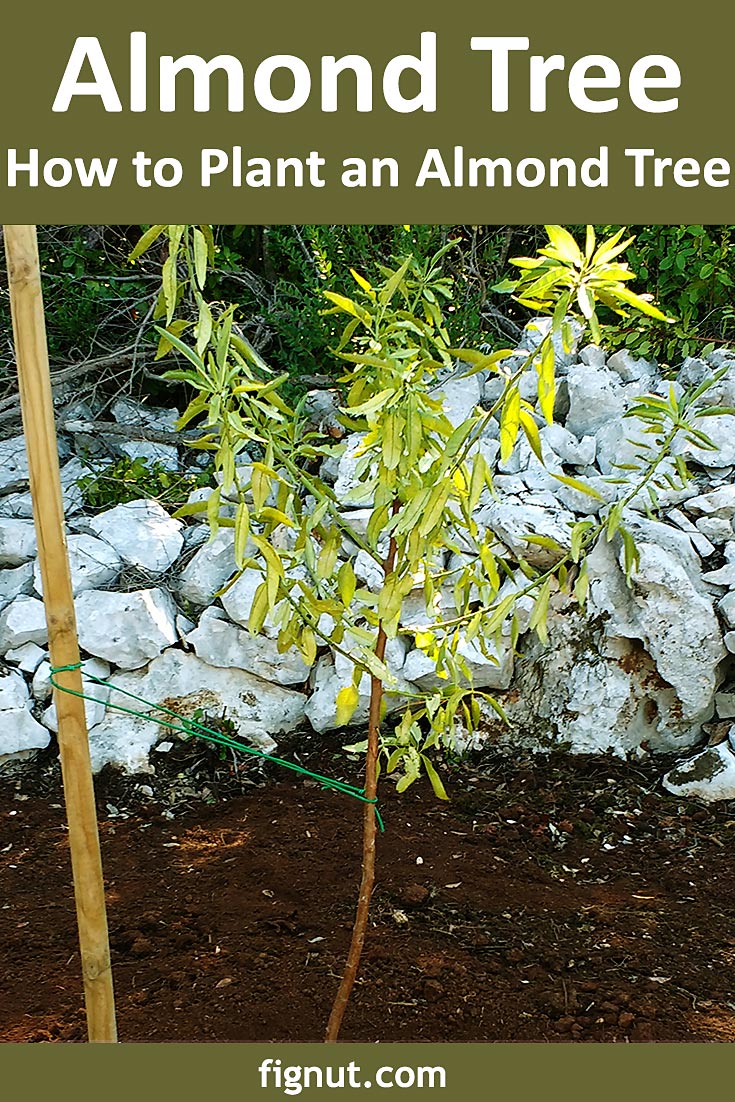How to plant an almond tree is a question that I struggled with just a few years ago. Before I inherited this piece of land I never planted any trees. However, I made some research, and by doing it several times since I am now confident that the best way to plant the almond tree is as I described below.
It is an easy and fairly straightforward process, anyone should be able to do it successfully. Here is how I do it, my detailed process, accompanied by photos of newly acquired trees and up to four-year-old trees – keep reading:
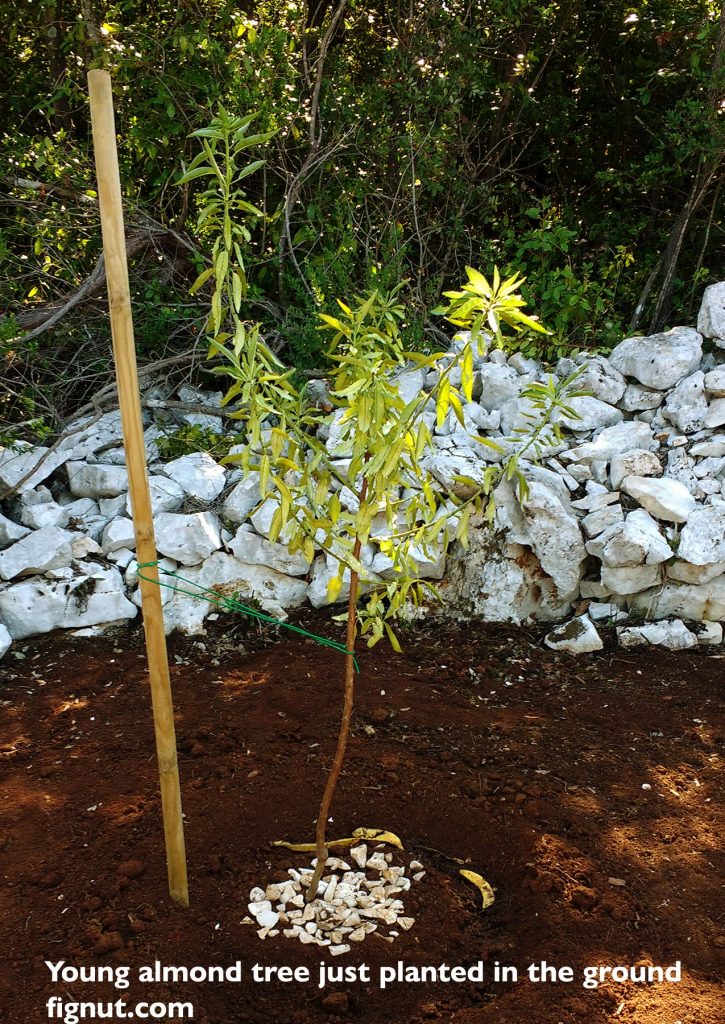
Table of Contents
Getting young Almond Trees
When I inherited this piece of land, besides planting fig trees, I also decided to plant some almond trees. I was reading about various ways how to plant young almond trees and decided to go for young, bare-root trees as they were much cheaper than potted ones.
Sometime in February, which is here the mid-winter, I ordered bare-root almonds from the nursery that was away, in another town. Pretty soon I got through the post the bag of 15 bare root almond trees – here is bag that arrived in the post:

Planting Trees in the Bags (Pots)
As soon as the trees arrived, I bought some strong, large plastic bags (to act as pots) and several bags of compost and planted all trees in them. Prior to planting it is important to make sure each bag has several holes at the bottom to ensure easy drainage.
The reason I choose bags instead of the plots is this was a cheaper solution. My plan was to replant the trees in the ground as soon as they are ready, which is following autumn (fall) so in my opinion, it was not viable to buy large pots just to use them for a few months.
Planting Location
The reason why I choose to plant them first in the bags and replant them in the ground is that the particular location where I planned to eventually plant the trees in the ground is on the hill, facing north-east (colder than average), and is also pretty windy location so in my opinion, it was much better to initially give young trees sheltered location to start with and replant them in the ground once they are bit stronger and their root system is better developed.
As you can see in the below photo, I placed bags (pots) near the garden wall which acts as a windbreak barrier, and secured them from the front side with large stones to keep them straight and upwards.
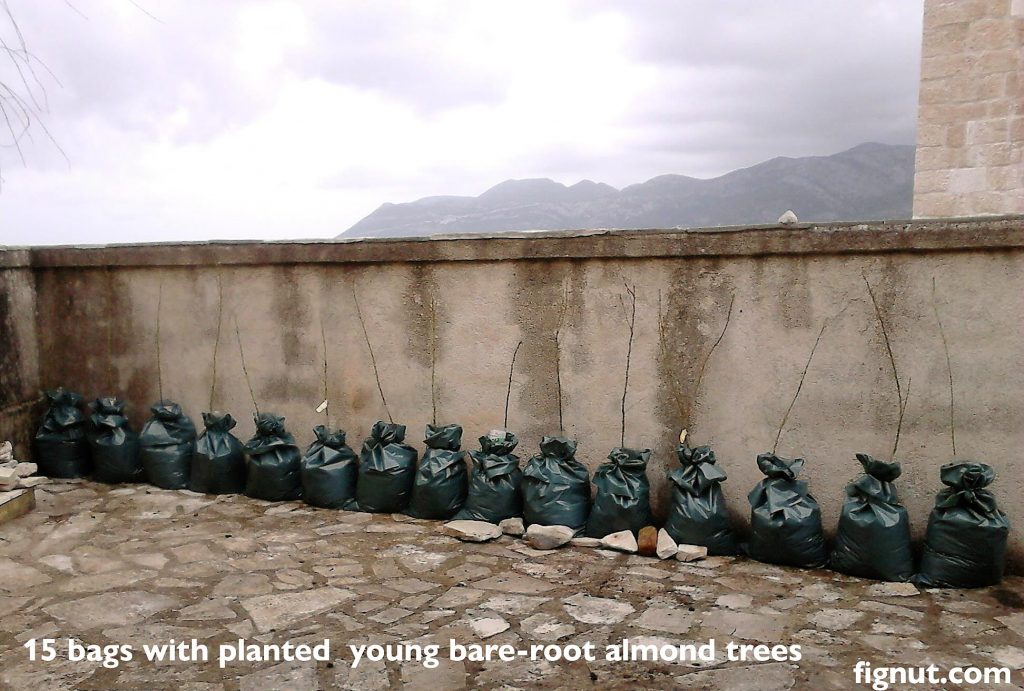
On the top of each bag I added a plastic bottle, cut it in half, and placed it upside down to make it easier to water the trees – see below photos:
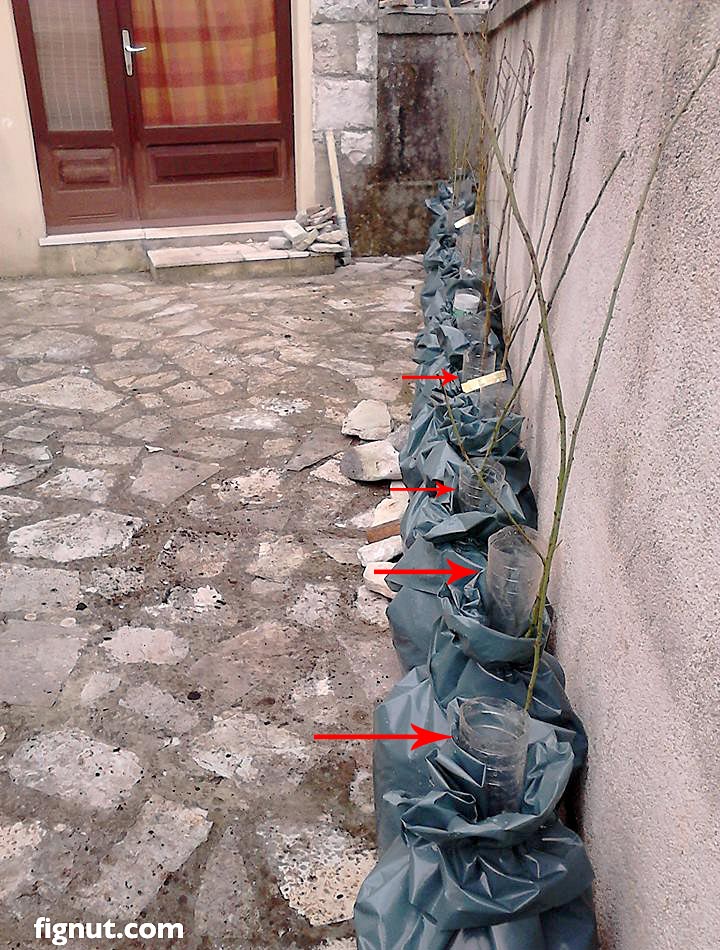
Top of the bag is tightened with a piece of string to improve stability of the bag (pot):
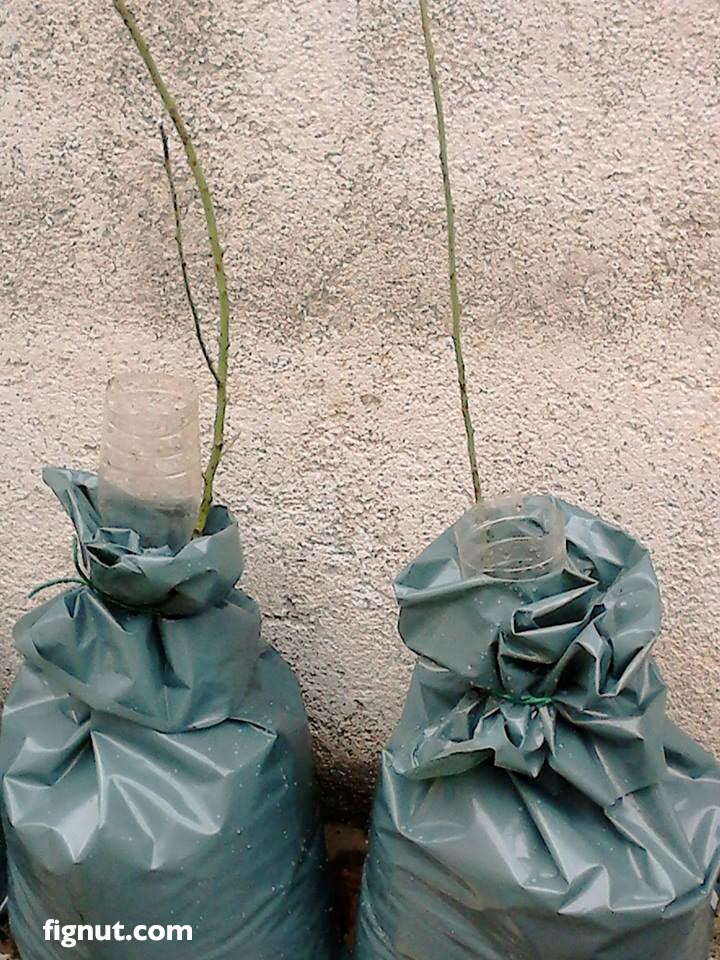
For the next few months, I kept watering them and waited for spring to see if any of the trees will shoot out the leaves.
Unfortunately, only seven trees survived and eventually got their leaves out while others just died. I kept all of them until autumn (fall) and waited but was still left with just seven live trees (below photo).
I talk to the nursery owner who sold me trees and he said that the reason for such a lot of them died is that winter was very cold with a lot of snow so in his opinion the very low temperatures (below freezing) killed some of the young trees.

As soon as spring arrived, I opened the top of the bags for easier watering and better control of drainage and tightened each of the alive trees with a supporting stick in case of the stronger wind.
I kept all seven trees for the whole summer in my patio garden, watering them and keeping them away from the strong sunshine while waiting for an autumn (fall) to plant them in the ground.
In the below photo, you can see trees are now in the center of the patio/terrace, away from the wall, to allow the sunlight to reach them from all sides and to enable branches to spread as much as possible at all sides of the trees. You can also see pots with the lavender plants that I grew from cuttings and Helichrysum Italicum (Dwarf Everlast) young plants also waiting for fall to be planted in the ground.

Planting Young Trees in the Ground
Sometime in mid-October, which is here early autumn (fall), the trees were ready to be planted in the ground. The weather was cooler with regular spells of rain which is an ideal time to plant them in the ground:

Ground Preparation and Planting
I started by preparing the ground. It is important that the ground is properly prepared before any planting. Young trees love soft ground around their roots as that encourages the roots to develop better and spread as wide as they can which is very important especially if the location is windy.
I dug a deep and wide hole about 70 cm wide and 90 cm deep, which is plenty of space for the root ball, add some fertilizer, and planted the trees into the ground. I also added a large support stick for each of them as winds here can be pretty nasty.
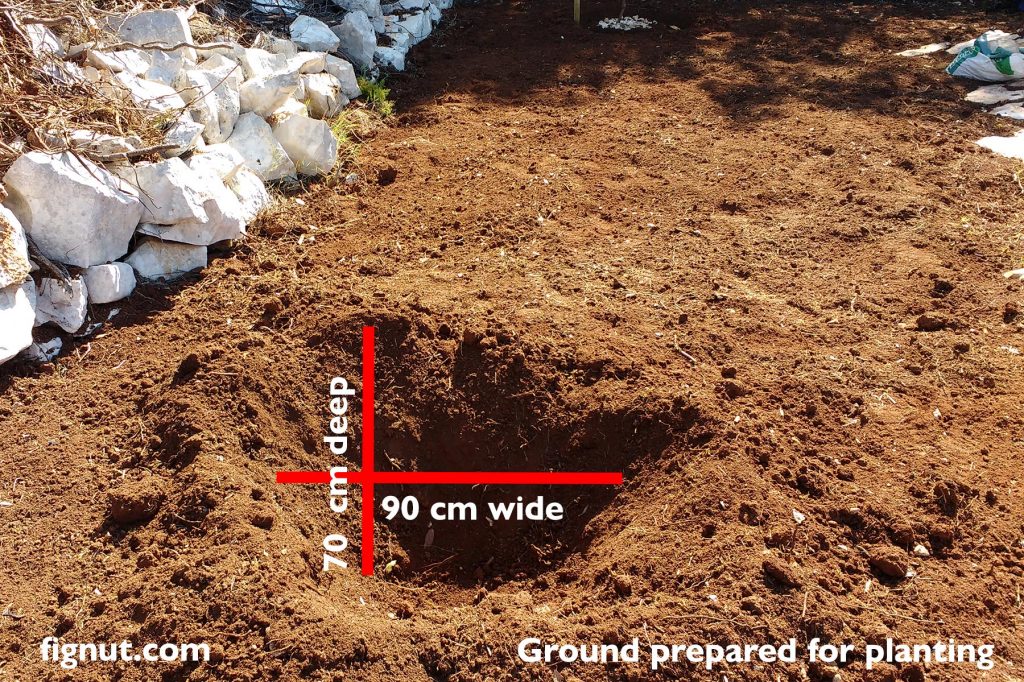
When planted, water them well. It is also a good idea to put some mulch around. I used small stones (there is plenty of them in this dry and rocky landscape) and spread them around the trunk to act as a mulch to prevent evaporation. Here are some photos of trees just planted in the ground:


For the rest of the winter I just let them grow and during following summer I water them once a fortnight.
In the first year, they did not produce any nuts, but in years 2 and 3 we harvested some, just about 1 kg (see how we eat them). It is not a lot but it was expected as it takes a good 5 to 7 years for new almond trees to come to full production.
Update: I succeeded to grow these trees for a few years now. They are now in their 4th year and last autumn they produced already some of the fruits. Here are some photos of the same trees in the following years:
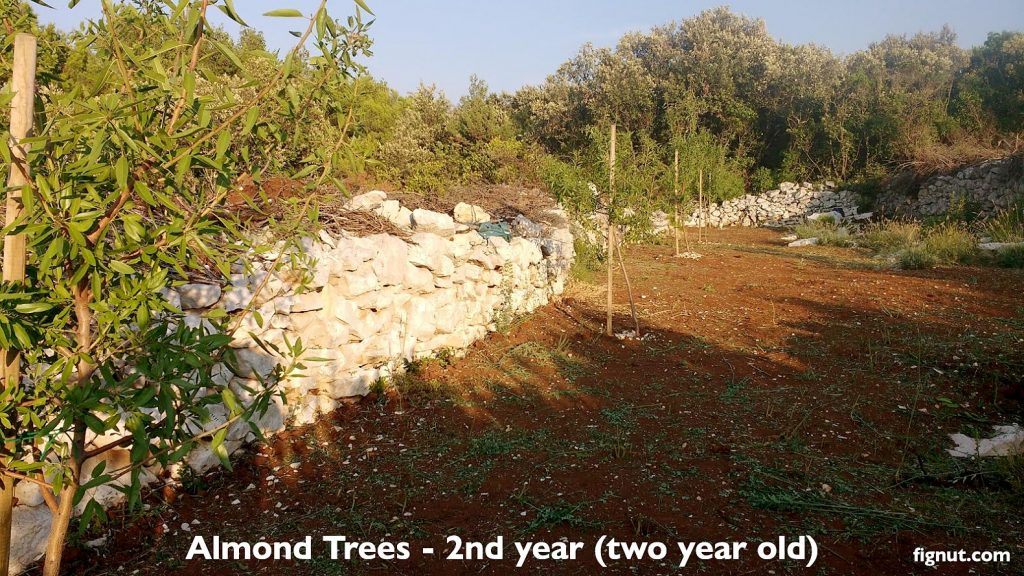
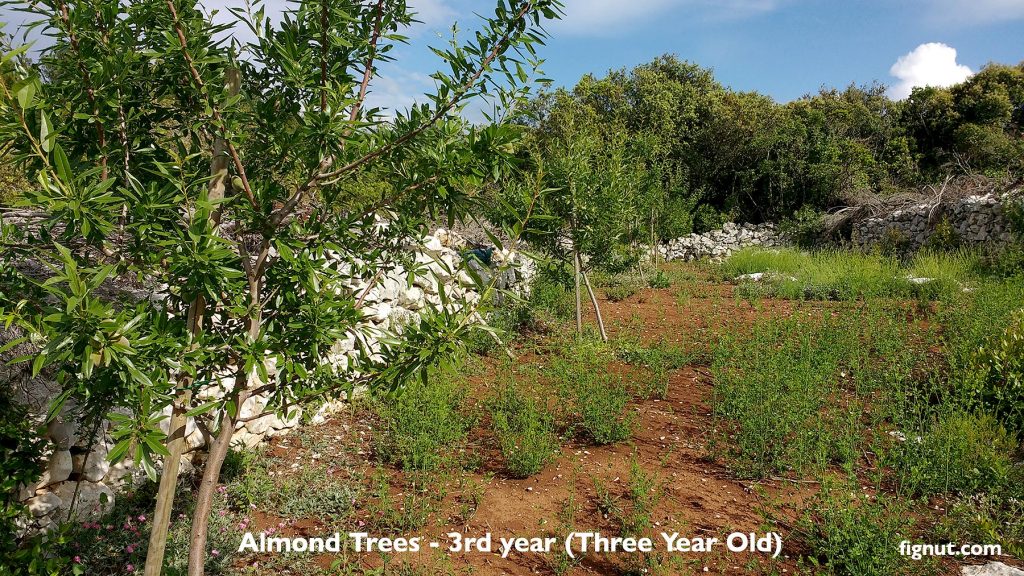
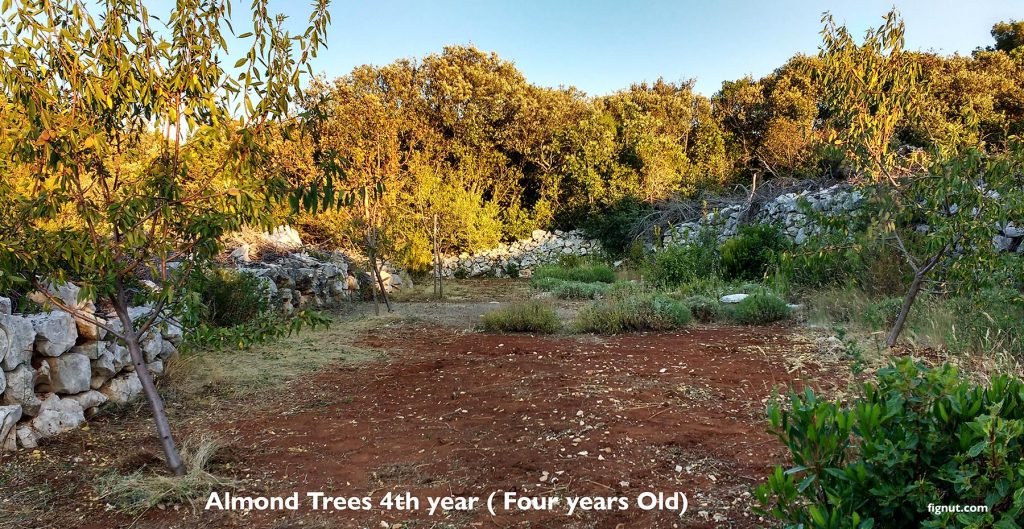
Important things to care about when planting almond trees
- Find a suitable location – where is the best place to plant an almond tree? Almonds like a sunny location. Find such a location in your garden and your tree will successfully grow for many years.
- Make sure that the space between your almond trees is at least 5 meters.
- Dig a hole deep and wide enough to be roomy enough to accommodate the root ball.
- Place a potted tree in the same depth it was growing in the bag or pot.
- Water the tree well especially if you are in a droughty climate. Add fertilizer.
What is the best time to plant an almond tree?
From my experience, the ideal time to plant a young almond tree is preferably before the rain. If you can’t make it then any time should be fine as long as you keep watering the tree at least once a fortnight in warm periods. Almond trees hardly need any watering in the spring, autumn or winter.
Summary
As you can see, planting almond trees, first in the bag and then in the ground is a fairly easy process, similar to planting any other tree (see here me planting fig trees in the ground, you can also see the video). I am happy with the results. I already started harvesting. Will follow up with other articles about caring for and maintaining my almond trees.

Articles about planting
- How to Grow Rosemary from Cuttings
- How to Plant an Almond Tree
- How To Propagate Lavender From Cuttings
- How To Start A Fig Tree From A Cutting
- How to Plant a Potted Fig Tree in the Ground
